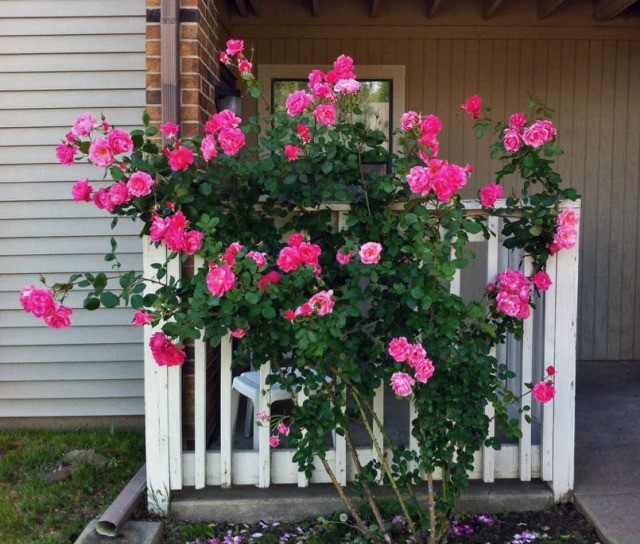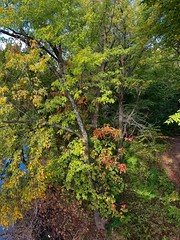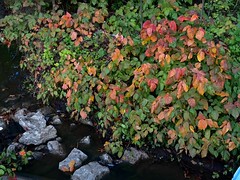December 21, 2015
Post by Wendy

Granger and I just finished building a raised rose bed at his place and transplanting a humongous rose bush. He and I will marry next July, so in the meantime we’ve been organizing as well as purging some of our various belongings. When he makes changes and improvements around his house in preparation of me coming over, he says he is “building his nest,” like a bower bird does to attract a mate. He’s added cabinets both within and without one bathroom to make me more at home. He has also agreed to a lot of gardening tasks that he wouldn’t normally do.Transplanting this climbing rose bush and building a bed for it were quite an undertaking for us both.
I’ve cared for many roses in the past; at one time I was tending 24 different bushes including hybrid teas, floribundas, grandifloras, climbers, shrubs, and miniatures. When I downsized to my apartment, I kept three of my original rose bushes – Perfume Delight, a deep pink hybrid tea; Dream Come True, a yellow and ruby grandiflora; and Social Climber, a pink climbing rose bush.
Social Climber is the commercial name of the pink rose bush I planted in memory of my Grandma Harper. In fact, after she passed away in the early 2000s, I started rose gardening to deal with the grief. So you could say that she got me started on that hobby.
After moving to Bartlesville, I began adding bushes to my garden and learned many things in the process. Around 2009, I was perusing the Jackson & Perkins Rose catalog and found Social Climber. The pink profusion of roses in the photo reminded me of a birthday card I once got from my grandmother, who we affectionately addressed as “Harper.” When my older sister was very young, she could not say “grandma,” so from that point on, Grandma Harper was called “Harper.”
When I planted the rose bush in her honor back in 2009, I named it the Harper Rose. I received the bare root in the mail and meticulously followed the directions and pointers I’d found online for planting bare root roses.
The Harper Rose bush is very special to me. Since I planted it in her honor, I gave it extra loving care and attention, much as I would give her if she were here. I grew up mostly in East Texas and had both sets of grandparents as neighbors. So my little sister and I spent many days visiting Harper and “Poopah” in their tiny trailer.
Their walls were completely covered with greeting cards that friends had sent. Usually we’d find Harper sitting with a large cloth napkin in her lap, eating stale toast and jelly, reading the Bible, and leaving crumbs everywhere. Writing letters and keeping up with old friends was a duty she took seriously. Kids these days have no concept of writing letters.
I really admired Harper because even though she had many painful ailments, she never complained. Back when she was middle aged, she tried to erect an American flag on Independence Day, and fell, injuring her elbow. From that point on, into her later years, she had to soak her elbow a few times a day to reduce the pain. To this day, when I smell BenGay, I think of her.
Harper had osteoporosis so bad that her back was humped over, making her look like a turtle. She later had to go to Mayo Clinic to get artificial elbows and knees. If this were not bad enough, she also suffered from glaucoma. I still remember her procedure for the special eye drops. After putting the drops in, she had to keep her eyes closed for a certain amount of time – the amount of time it took her to recite Psalm 23 which begins, “The Lord is my shepherd I shall not want…”
Harper was very dear to me, so as a result, I take great care of the rose bush that is her namesake. I planned a raised bed to be made from cinder blocks and even planned the composition of the dirt. Many years of rose research helped in this endeavor. What I’ve learned about rose-growing has led me to one simple recipe for rose success: Good sun, good drainage, good dirt, good fertilizer, and water regularly. All of these necessary ingredients were considered when planning this rose bed.
At my apartment, the Harper rose bush got morning sun, which helped it to thrive. Six or more hours of direct sunlight is the usual recommendation, so Granger and I selected a spot in his yard that met that standard.
Building the Raised Bed
We measured and dug a shallow, square trench within which to place the first layer of blocks. We saved the clay-rich dirt on an old sheet in the yard. Too much clay is not good for roses as it prevents good drainage. But I wanted to save some of it in case the soil we created ended up having too much drainage. I didn’t want any of that invasive Bermuda grass in the bed, so we spent a lot of time removing clumps of it from the clay dirt.
It is said that roses don’t like to sit in water as it rots their roots. So we first put in gravel to help with drainage. Then we put down some wire mesh, the kind one might use to build a chicken pen or a rabbit hutch. In our case, we put it down to deter the hungry moles who have been taking over the yard. Next, we put down landscaping cloth to keep the weeds out. Finally, we laid down the first layer of cinder blocks and threw in some more gravel.
Putting down those heavy blocks was tiring, so a few days later we put down the second course. Later a third course was placed. In all, there are 27 blocks. We put that heavy clay dirt into the holes in the blocks to make them even more stable. All the while, we were adding various ingredients to the bed soil: bags of top soil, pine bark mulch, potting soil, enriched garden soil, compost that Granger and I had created over the past year, blood meal, clay dirt, gravel, gypsum rocks from one of our hikes, chopped banana peels, more egg shells that hadn’t made it to the compost barrel, and some wet, partially decomposed dead leaves.
The last step in the construction involved gluing down shorter cinder block caps which matched the lower blocks in two dimensions. They create a place for me to sit when I tend the rose bush.
Transplanting
For weeks, I considered the transplanting process and how best to execute it. So many warnings danced around in my head: Keep as many roots intact as possible; keep as much of the native dirt around the roots as possible; don’t let the roots sit out in the air for too long; protect the canes in transport; for climbers, it’s best to avoid pruning the main canes: only prune the side branches; remove all foliage so that the plant uses its energy for growing roots and adjusting to the change of environment; only transplant during the dormant phase…
Well, there is no dormant phase for this bush. It’s a vigorous grower, and even in December, it’s showing new little reddish sprouts of leaves popping out of the canes. It’s like a happy little dancing child. But I had to move it. Ready or not, here we go.
I had no idea how big the root ball would be, but I was about to find out. First I cut up some old shirts into strips and squeezed the canes together as much as I could without breaking them. Those canes are as big around as carrots. The heavy wind made it quite difficult to wrap cloth strips around the spread out and thorny branches; just when I thought I had the strip wrapped around behind the bush, the wind would whip it back out or get it stuck on a thorn.
There was a lot of wrapping of branches, not only to confine them but to protect myself from the huge thorns. I didn’t wear gloves since it is hard to tie things up using bulky elk skin gloves. So my hands got pretty well butchered.
After the wrapping of canes, I got a small blanket and wrapped it around the bush, tying it all up with duct tape. Then with the bush contained and rendered harmless, I got to digging. In a circle about a foot away all around the bush, I’d stand on the shovel wiggling it side to side and then sit on the handle of the shovel. I did this over and over, huffing and puffing, sweating up my coat. Down, under, and up, down, under, and up. That bush was a beast. I didn’t realize how heavy the plant was until I was on the grass, my arms wrapped around it, pulling it free of its home, panting,“Come on, Harper! It’s time to go!”
I laboriously hefted it onto the big piece of cloth I’d laid out. Then I got to work, tying that cloth around the root ball. There were two long roots popping out, and I didn’t want to damage them, so I let them stick out freely.
The next big feat was lifting the plant to put it into the shallow rubber basin for transport. Granger had asked me earlier, “Do you want me to come over to your place and help dig up that rose bush?” And I had foolishly told him I could do it myself. With a primal grunt, I lifted rose bush, basin and all, into the trunk of my Impala. I think I used up all of my calories from breakfast in that one lift.
After chugging a Gatorade and replenishing my shaky, depleted body with a snack bar, I carefully wrapped some exposed canes. I did this so that they would not be damaged by the trunk lid, which could have potentially bounced up and down as I drove the three-minute drive over to Meador Manor. Finally I tied a strip of red cloth to the longest cane just in case another car tried to follow too closely. Wouldn’t want them to get gored to death.
Actually that cane had been closer to ten feet long in the past. Recently, it had grown so high that it touched the railing of the floor above my apartment. I had tied it back down so it would not intrude on the upstairs neighbors’ plants. Trying to confine the Harper rose bush to my tiny garden space has been a major chore over the last three years. I’m glad it will have space to roam in its new home. It’s a sprawler.
Once I got the bush to Granger’s place, he helped me unload it into the Worx Aerocart he bought a few months ago for my gardening projects. That cart has been used a lot, what with all of the cinder blocks, loads of loose and bagged dirt, and gravel.
When we got the bush into the back yard, I dug a big hole in the bed of dirt. Then I got some of the clay and heavier dirt and formed a large cone in the middle of the hole. This helps give the roots something from which to “fan out”. We hefted the bush up and down into the hole, gently pushing it down onto the dirt cone. Then we adjusted it to where those long roots sticking out had a little more room. We adjusted the height where it sat to be sure the bud union was slightly underneath the top layer of dirt. Granger held the bush in place while I adjusted the roots and filled the hole with water. When it was full, I stood back and studied the canes to be sure they would fan out in the proper directions. For years I’ve been “training” those canes to spread and grow the way I want.
With Granger still holding the bush in place, I started backfilling the hole with dirt, gently packing around the roots to remove all air bubbles. Once we got the plant packed in and all of the dirt in, we went to work unwrapping the canes and cutting off the tie-downs. I tied one cane over to another so that it would not cross and damage an adjacent one. Over time the cane will grow in the direction I desire. I’ve often heard people say that their rose bushes are taking over their place. I tell them to not be afraid to cut on bushes or control errant branches by loosely tying them down. To make that rose bush do what you want, you’ve got to tame it and train it – especially climbers. It’s just like having discipline with kids. Structure and boundaries are paramount.
Love and care are also important. Speaking of love and care, two weeks ago, Granger showed up at my front door with a bouquet of red roses and a big smile. I heard a song playing on his iPhone in his pocket. It was Frank Sinatra singing, “Try a little tenderness…”
Like loved ones, rose bushes need tenderness in the form of regular attention and loving care. I’m counting on Granger to deeply water the Harper rose bush for the next couple of days. And I’m eager for next summer when we get back from our honeymoon in Oregon and start our married life together. Then I will get to give Granger and Harper the daily love and care that they both need.
Granger has literally “promised me a rose garden” and helped me to build it. This contrasts with the old song by Lynn Anderson.
[youtube https://www.youtube.com/watch?v=WO4wcNVbYOQ]
Lynn Anderson Rose
Coincidentally, I recently took a photo of the rose named after Lynn Anderson at the Tulsa Rose Garden. There’s a neat story behind this rose and how it came to be named for the country singer:
As a thank-you gift to the country singer for donating a copy of her 1971 gold album Rose Garden to the American Rose Society’s 100th anniversary convention auction, says Anderson, “they sent me photos of six roses and great descriptions of them to choose from. The one I chose said ‘extremely hardy’ and I thought that description suited me to a ‘T’.” In her xeriscape garden at her home in New Mexico, Anderson grows many plants, including high-altitude wildflowers and cacti. Because she has a dry, rocky soil in combination with a busy travel schedule, Anderson donated several of her rose bushes to the Chamber of Commerce, the local hospital and a women’s center in Taos, N.M. “That way they’re cared for by pros, and lots of people get to see and enjoy them.”
Lynn Rene Anderson (September 26, 1947 – July 30, 2015)















Please tell me where I can obtain the Harper rose in tribute to my great granddaughter Harper.
That is just Wendy’s name for the Social Climber climbing rose: https://www.jacksonandperkins.com/social-climber-climbing-rose/p/v1624/